Glossing system used for songs and ritual texts
David Bar-Tzur
Created 26 November 2005, links updated monthly with the help of LinkAlarm.
Key to abbreviations and symbols (Cokely-Baker2 & Bar-Tzur)
- [A^]
- the [A] handshape has the index finger curled under it like the sign CONTROL or STRIKE-MATCH
- "all"
- sign is swept to the right, as if performing the action for everyone (on everything) at the same time
- alt.
- alternating, that is executed by DH, then NDH, then DH, as in PEOPLE
- antisymmetrically
- hands behave like the opposite of a mirror image, as in WIND
- [As]3
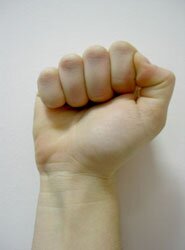
- the A handshape but the thumb is tucked against the index finger
- away
- away from signer, as in "PO away"
- [B]3
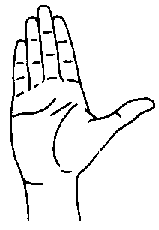
- the B handshape but the thumb is not tucked into the palm, as in SCHOOL
- [B^]1
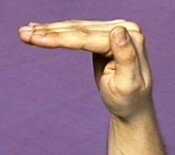
- the handshape is modified so that fingers are held at 90º angle to palm, as in EQUAL as illustrated with one hand in this entry
- [Bb^] or [B||]
- is the handshape for MEETING when it is halfway closed
- [Bb]1
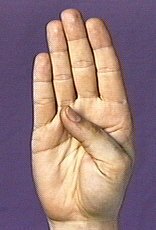
- the B handshape with the thumb tucked into the palm as in TROUBLE or WORRY
- [bC]
- the C handshape with only the thumb and index fingers extended and curled, called "baby C", as in the DH of WORD.
- [bO]3
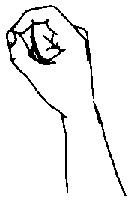
- the O handshape with only the thumb and index fingers extended and curled, called "baby O", as in EXACT
- [bX]
- thumb is placed over the middle joint of [X] as in some variants of CONTROL (as if holding onto the reins)
- CCW
- counterclockwise (as seen from above or from DS) as in WE. Note that this is for the signer who is right-handed. CCW for the left-handed will become CW and vice versa. I devised a handedness-neutral notation, but it is too complicated and therefore confusing.
- cs
- the DS of chin is brought closer to the DS shoulder which shrugs up to meet it (cs is from "chin to shoulder"), which shows that something recently happened or is close to something else
- ctr
- center
- CW
- clockwise (as seen from above or from DS) as in THEREABOUTS/APPROXIMATELY. Note that this is for the signer who is right-handed. CW for the left-handed will become CCW and vice versa. I devised a handedness-neutral notation, but it is too complicated and therefore confusing.
- DFT
- fingertips of dominant hand
- DH
- dominant hand
- dorsal side
- not the palm side, but the other side of the hand or arm.
- downward arc(s)
- a movement that resembles the curvature of a "U" that swoops down in a semi-circle and then returns to the level that it began at.
- DPO
- dominant palm orientation
- DS
- dominant side (right if you are right-handed, left if you are left-handed)
- "each"
- sign is repeated three times: at NDS, at center, at DS
- flick index finger1
![initial position of [flick index finger] handshape illustrated](/handshape/cockedindexfinger.jpg)
![final position of [flick index finger] handshape illustrated](/handshape/indexfingerb.jpg)
- The second picture has the PO wrong, but you get the idea; as in UNDERSTAND
- FO
- fingertip orientation (if fingers were extended), so that EQUAL might be mistaken as FOs ><, but linguists would call the FO up
- FT
- fingertips
- (<) GLOSS-1, (>) GLOSS-2
- this shows body shift: the first part is signed while the body is shifted to the NDS, and the second part shifted to the DS
- HON.INDEX
- the honorific index points to things with the FT of [B] with its palm upturned
- [horns]1
![[horns] handshape illustrated](/handshape/horns1.jpg)
- handshape where the index and pinky fingers are extended, as in MOCK
- hu
- a sudden intake of air with rounded lips as in CRAZY-FOR/WOW
- [ILY]
- thumb, index and pinkie finger extended, as in I-LOVE-YOU
- [IRY]
- thumb, index, middle finger and pinkie finger extended, and index and middle fingers crossed, as in SPACE-SHUTTLE
- ITALICS
- sign this with NDH
- lf
- left
- mm
- lips are pouted to show regularity
- NDPO
- non-dominant palm orientation
- NDFT
- fingertips of non-dominant hand
- NDH
- non-dominant hand
- NDS
- non-dominant side
- [open 8]
- the handshape for the sign FEEL
- "over time"
- sign is repeated with circular motion to show action happens over a long time period, at least psychologically
- PO
- palm orientation
- POSS.
- possessive, that is, [B], PO towards whatever is being referenced
- pronate
- hand is twisted so that PO is down or away from the signer, as in lying prone before the emperor
- RECT-CL
- (2h)L, PO away, FO up, touch like FTs and separate while closing to (2h)bO to trace out a rectangle in air
- rt
- right
- "step by step"
- sign is executed slowy in several small steps, as in PROCESS
- supinate
- hand is twisted so that PO is up or towards the signer, as in COMPLETE; think of SuPINate as being on the SPINe.
- symmetrically
- hands behave as in a mirror image, as in the sign SEPARATE
- t
- the eyebrows are raised and the head is brought forward by the neck and tilted back slightly
- th
- the tongue sticks out slightly while the mouth forms the phoneme "th", showing carelessness or inattentiveness to detail or rightness
- thp
- the tongue sticks out slightly while the mouth forms the phoneme "th", then the tongue is retracted and the mouth shuts like a "p"
- tl
- stands for "tight lips" which shows seriousness or effort
- upward arc(s)
- a movement that resembles the curvature of an inverted "U" that swoops up in a semi-circle and then returns to the level that it began at.
- [V:]1
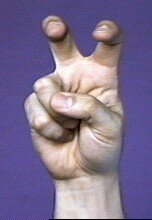
- the colon means curl the fingertips of the handshape, as in BLIND
- (v)
- verb form, not noun form
- wg
- wiggle fingers, as in STUDY, not as in FIVE-HUNDRED
- whu
- air is blown out of rounded lips as in the sign HAVE-NONE
- [X]
- a letter or number inside brackets indicates a handshape
- [X dot]
- the handshape is modified by extending thumb, as in the [A dot] of REFUSE
- [X^]
- the handshape is modified so that fingers are held at 90� angle to palm, as in the (2h)[B^] of EQUAL
- [X:]
- the colon means curl the fingertips of the handshape, as in the [5:] of WANT
- X,Y
- first handshape is for NDH, second is for DH, as in "leak from hole": F,4-CL
- X>Y
- first handshape becomes second handshape as in "disappear into the distance": G>bO-CL
- zz
- teeth are clenched
- (1h)
- one hand is used instead of the usual two-handed sign
- 1outline-CL
- the index finger traces (outlines) the shape of an object, as in ELLIPSE, which could be glossed as 1-CL'ellipse'.
- 1x, 2x, 3x
- once, twice, three times (sometimes notated x1, x2, x3); used instead of "+" when sign is usually produced twice, but now once (or vice versa), or in descriptions that do not use the gloss, so there is no sign to add "+" to
- (2h)
- both hands have the same handshape or the usual one-handed sign is produced with both hands
- [5:]1
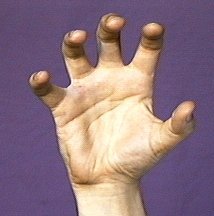
- the colon means curl the fingertips of the handshape
- [5^]3
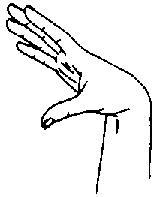
- the carot (^) means bend the fingers at the knuckles, but keep them straight as in the final position of SUNSHINE
- :
- The fingertips are curles as in [5:] for ANGRY
- @
- at, as in SURGERY@brain for "brain surgery"
- #
- lexicalized fingerspelling (previously called fingerspelled loan sign), as in #OK for OKAY.
- *
- sign is executed with short forceful movement, as in MAD* to show that someone is "furious"
- >
- towards, as in "> DS"
- ><
- face each other, as in POs ><, which is the case for the sign MEET
- ^
- the handshape is modified so that fingers are held at 90� angle to palm, as in the (2h)[B^] of EQUAL
- ~
- The two signs are blended together smoothly
Glossing techniques (Cokely-Baker)
- Each sign is represented by an English word or phrase in all capital letters and may be in bold: ME SPEAK HEBREW CAN.
- Initialized signs are indicated by the substituted handshape, a dash, and the base sign: A-CALCULATE for "algebra".
- Fingerspelled vocabulary is indicated by bolded upper case letters separated by dashes: P-H-A-S-E for "phase". A single fingerspelled letter is enclosed in quotes: "E".
- Signs that are generated by repetition of base signs, are indicated with a plus sign. HELP++ for "helpful".
- Signs that are blends of other signs can be represented by a tilda (~) TRUE~WORK for "actually".
- If a sign uses parts of the body as a direct object, the sign is followed by an at symbol (@) and the body part described in lowercase letters: HURT@(left hip) for "my left hip hurts".
- If spatialization and directionality are used, "lf"," rt", "ctr" can be used for "left", "right", and "center".
More detailed description (Cokely-Baker, Bar-Tzur)
- For signs that can not be related to signs that have a standard gloss, a more complex system is used.
- If the sign is two-handed and the handshapes are the same, (2h) is used and then the handshape is enclosed in square brackets. (2h)[F] would be the handshapes for the sign JUDGE.
- If two-handed, but the handshapes are different, DH (dominant hand) is used, indicating the handshape, later listing NDH (non-dominant hand). NDH may be omitted since the other handshape must now be on the NDH. For POPULAR, the handshapes would be NDH [1] and DH [5].
- Palm orientations are specified: PO up, PO down, PO > NDS (non-dominant side), PO > DS (dominant side), PO towards (towards signer), PO away (away from signer), POs >< (palms face each other). Here are the POs for some more signs: STOP (NDPO up, DPO > DS), WARN (both hands PO down), MEET (POs ><), EMERGENCY (PO away), MIRROR (PO > signer).
- FO specifies fingertip orientation, similarly to PO. Remember FO is defined in linguistics as the direction the fingertips would point if they were extended, not based on a closed HS, so that EQUAL would be FOs up, not FOs ><.
- If handshapes are used as classifiers, information showing how the classifier moves is described in single quotes, such as 1-CL'person walk up to me suddenly'.
- If the NDH stays in place from a previous sign while the DH continues a new sign, a dashed arrow can show the duration of the hold.
- Examples of a full glossing would be: (1) RACE/COMPETE - (2h)[A], POs ><, FOs away, alt. move FO from up to away with hands held close together. (2) AWFUL - DH [8], PO > NDS, FO up, is held over shoulder and moves away while flicking middle finger to become a [5]. (3) WIND - (2h)[5], POs ><, FOs away, sway antisymmetrically from side to side while pronating and supinating the palms.
Footnotes
1. ASL University: Handshapes
2. As described in Baker-Shenk, C. & D. Cokely (1991). Clerc. ISBN 093032384X.
3. Turkish Sign Language.

Home




![initial position of [flick index finger] handshape illustrated](/handshape/cockedindexfinger.jpg)
![final position of [flick index finger] handshape illustrated](/handshape/indexfingerb.jpg)
![[horns] handshape illustrated](/handshape/horns1.jpg)







![initial position of [flick index finger] handshape illustrated](/handshape/cockedindexfinger.jpg)
![final position of [flick index finger] handshape illustrated](/handshape/indexfingerb.jpg)
![[horns] handshape illustrated](/handshape/horns1.jpg)



